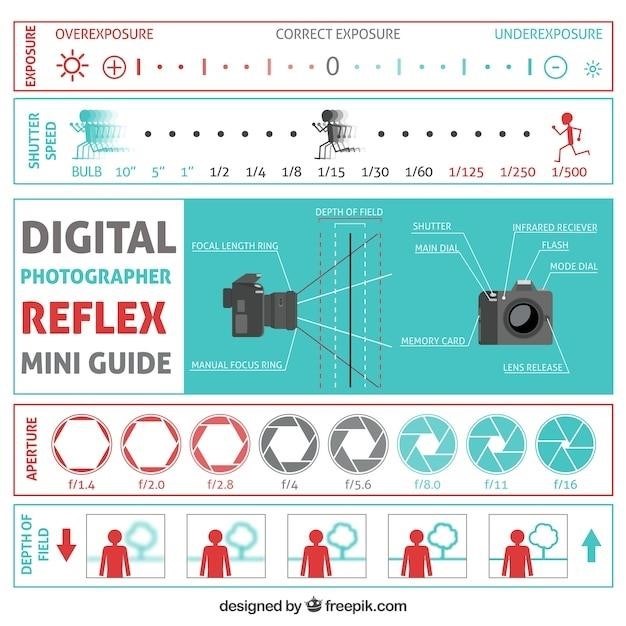Nikon D3100 User Manual⁚ A Comprehensive Guide
This comprehensive guide provides a detailed walkthrough of the Nikon D3100 user manual, covering everything from essential features and specifications to advanced techniques for capturing stunning photos and videos. Whether you’re a beginner or an experienced photographer, this guide will equip you with the knowledge and skills to master your Nikon D3100 and unleash your creativity.
Introduction
Welcome to the world of digital SLR photography with the Nikon D3100, a camera designed to empower photographers of all levels. This user manual serves as your comprehensive guide to unlocking the full potential of your D3100, helping you capture stunning images and create breathtaking videos. From the basics of operation to advanced shooting techniques, this manual will provide you with the knowledge and confidence to explore the creative possibilities of your camera.
The Nikon D3100, released in 2010, was a game-changer in the entry-level DSLR market. It offered a compelling blend of affordability, user-friendliness, and impressive image quality. This manual aims to guide you through the camera’s features, settings, and functionalities, enabling you to make the most of its capabilities. Whether you’re a novice photographer eager to learn the fundamentals or an experienced user seeking to delve deeper into the D3100’s advanced options, this manual is your essential companion.
Get ready to embark on a journey of photographic exploration with your Nikon D3100. This manual will be your trusted resource, empowering you to capture the world around you with clarity, detail, and artistic expression. Let’s begin!
Key Features and Specifications
The Nikon D3100 boasts a compelling set of features designed to elevate your photography experience. At its core is a 14.2-megapixel DX-format CMOS sensor, capturing detailed images with vibrant colors. The camera’s EXPEED 2 image processing engine ensures exceptional image quality, delivering rich tones and smooth gradations. The D3100’s autofocus system utilizes 11 focus points, providing quick and precise focusing for sharp results, even in challenging lighting conditions.
The camera’s intuitive Guide Mode simplifies photography for beginners, offering step-by-step instructions for various shooting scenarios. For those seeking more control, the D3100 offers manual shooting modes, allowing you to fine-tune aperture, shutter speed, and ISO settings for creative expression. The D3100 also supports Full HD 1080p video recording at 24, 25, and 30 frames per second, capturing high-quality videos with impressive clarity.
Beyond its core features, the D3100 offers a range of practical functionalities, including a built-in flash for low-light situations, a 3-inch LCD monitor for clear image review, and a variety of shooting modes tailored to specific photographic scenarios. With its combination of user-friendly features and impressive image quality, the Nikon D3100 makes digital SLR photography accessible and rewarding.
Download and Access
Accessing the Nikon D3100 user manual is a straightforward process. Nikon provides a direct link to download the official PDF manual, ensuring you have the most up-to-date information. Alternatively, you can navigate to Nikon’s official support page for the D3100, where the manual is readily available. The manual is typically presented in English, offering a comprehensive guide to the camera’s features, functions, and operation.
For those who prefer a digital format, the manual can be downloaded directly to your computer or mobile device. This allows you to access the information anywhere, anytime, making it convenient for quick reference or in-depth study. Additionally, online resources like manualslib.com offer a searchable database of user manuals, including the Nikon D3100, providing another avenue for accessing the essential information you need.
Whether you prefer the official PDF version or an online resource, the Nikon D3100 user manual is readily accessible, enabling you to explore the camera’s capabilities and enhance your photographic journey.

Guide Mode
The Nikon D3100 boasts a user-friendly Guide Mode, designed to simplify the learning curve for novice photographers. This mode acts as an interactive tutorial, guiding users through essential camera settings and techniques. When activated, the Guide Mode displays helpful tips and explanations on the LCD screen, making it easy to understand and apply various shooting modes and functions.
For instance, the Guide Mode can help you choose the appropriate shooting mode based on the scene or subject, such as selecting “Portrait” for capturing people or “Landscape” for scenic shots. It also provides step-by-step instructions on adjusting settings like aperture, shutter speed, and ISO sensitivity, allowing you to experiment with different techniques and achieve desired results.
This mode is a valuable resource for beginners, helping them gain confidence in using their Nikon D3100 and develop their photographic skills. By offering clear explanations and practical examples, the Guide Mode empowers users to explore different settings and capture beautiful photographs with ease.
Live View
The Nikon D3100 incorporates a Live View feature, allowing you to compose and focus your shots directly on the LCD screen, eliminating the need to look through the viewfinder. This mode is particularly useful for shooting in challenging lighting conditions or when using a tripod, as it provides a clear and stable image for precise framing.
Live View offers several shooting options, including “Live View shooting,” which allows you to capture photos with the LCD screen as your viewfinder. You can also utilize the “Live View zoom” function to magnify the image and refine your focus, especially for detailed close-up shots.
Furthermore, the D3100’s Live View mode supports “Live View movie recording,” enabling you to capture high-quality videos directly from the LCD. This feature offers a convenient way to record events or create cinematic footage with ease.
Shooting Modes
The Nikon D3100 offers a variety of shooting modes designed to cater to different photographic situations and skill levels. The camera’s Mode dial provides access to these modes, allowing you to select the best option for your desired outcome. These modes include fully automatic options for beginners, semi-automatic modes for intermediate users, and manual mode for experienced photographers seeking complete creative control.
The D3100’s “Auto” mode is ideal for point-and-shoot photography, where the camera automatically adjusts settings for optimal results. The “Scene” mode provides a selection of pre-programmed settings optimized for specific scenarios, such as landscapes, portraits, and macro photography. This mode simplifies shooting in challenging situations by automatically adjusting exposure, white balance, and other settings.
For more control over your images, the D3100 offers “P” (Programmed Auto), “S” (Shutter-priority Auto), “A” (Aperture-priority Auto), and “M” (Manual) modes. These modes allow you to prioritize specific camera settings, such as shutter speed or aperture, while the camera automatically adjusts the other settings to maintain proper exposure.
Exposure Settings
Exposure settings play a crucial role in determining the brightness and overall look of your photographs. The Nikon D3100 provides a range of tools and controls to help you achieve the desired exposure for your images. These settings include shutter speed, aperture, ISO sensitivity, and exposure compensation. Understanding and mastering these settings will enable you to capture well-exposed images in various lighting conditions.
Shutter speed controls the duration for which the camera’s shutter remains open, allowing light to reach the sensor. A faster shutter speed freezes motion, while a slower shutter speed creates a sense of motion blur. Aperture, on the other hand, determines the size of the lens opening, controlling the amount of light entering the camera. A wider aperture (smaller f-number) creates a shallow depth of field, blurring the background and highlighting the subject, while a narrower aperture (larger f-number) increases depth of field, keeping both the foreground and background in focus.
ISO sensitivity determines the camera’s sensitivity to light. A lower ISO setting requires more light, resulting in less noise, while a higher ISO setting allows for shooting in low light but introduces more noise. Exposure compensation allows you to adjust the overall brightness of your images, adding or subtracting light to achieve the desired exposure.
Playback and Image Management
Once you’ve captured your images, the Nikon D3100 offers a variety of tools for reviewing, managing, and editing your photos. The camera’s playback mode allows you to view your images on the LCD screen, zoom in for detail, and rotate or crop them. You can also delete unwanted images or protect important ones from accidental deletion. The D3100 also supports a range of image management features, including the ability to create slideshows, organize images into folders, and rate your photos.
For more advanced editing, the D3100 offers basic retouching options, such as red-eye correction, brightness and contrast adjustments, and cropping. You can also use the camera’s built-in image processing engine to create JPEG copies of RAW (NEF) files, allowing you to experiment with different picture controls and color adjustments. The D3100 also supports direct printing to compatible printers, making it easy to share your photos with friends and family.
In addition to the camera’s built-in features, you can also transfer your images to a computer for more extensive editing using software like Adobe Photoshop or Lightroom. With the D3100’s comprehensive playback and image management capabilities, you can easily review, organize, and enhance your photos to showcase your photographic talent.
Troubleshooting and Maintenance
While the Nikon D3100 is a reliable camera, occasional issues may arise. The user manual provides a helpful troubleshooting section, covering common problems and their solutions. If you encounter an error message, refer to the manual’s index to quickly find the relevant information. It offers guidance on resolving issues such as camera malfunction, lens errors, and memory card problems. For more complex issues, Nikon’s website provides comprehensive support resources, including FAQs, tutorials, and contact information for technical assistance.
Regular maintenance is crucial to ensure your D3100’s longevity. The manual outlines essential maintenance practices, such as cleaning the camera body and lens, inspecting the battery and charger, and storing the camera in a dry, cool environment. Avoid exposing the camera to extreme temperatures, dust, or moisture. Regular cleaning and proper storage will help prevent damage and prolong the life of your D3100. By following these simple steps and utilizing the available resources, you can troubleshoot any problems and keep your camera in optimal condition.
Remember, the user manual is your comprehensive guide to understanding and maintaining your Nikon D3100. By familiarizing yourself with its contents, you can confidently resolve any issues and enjoy years of reliable performance from your camera.
Nikon D3100⁚ A Comprehensive Guide
The Nikon D3100, released in 2010, was a popular entry-level DSLR known for its user-friendly interface and impressive image quality. Its 14.2-megapixel CMOS sensor, coupled with Nikon’s EXPEED 2 image processing engine, delivered vibrant colors and sharp details, making it suitable for various photographic pursuits. The D3100 offered a range of shooting modes, from automatic to manual, catering to photographers of all skill levels.
The D3100’s intuitive Guide Mode made it a great choice for beginners, providing step-by-step instructions for various shooting scenarios. Its Live View mode allowed for framing and focusing through the LCD screen, offering a convenient alternative to the viewfinder. The camera also featured a 11-point autofocus system, ensuring accurate focus for sharp images. The D3100’s ability to capture Full HD videos at 24p, 25p, or 30p made it a versatile tool for both stills and moving images.
The D3100’s user manual, available online and in PDF format, provided a comprehensive guide to its features and operation. It covered everything from basic camera controls to advanced shooting techniques, making it an essential resource for maximizing the D3100’s potential. Whether you’re a casual photographer or a seasoned enthusiast, the Nikon D3100 user manual offers the knowledge and insights needed to harness this camera’s capabilities and create stunning photographs and videos.



